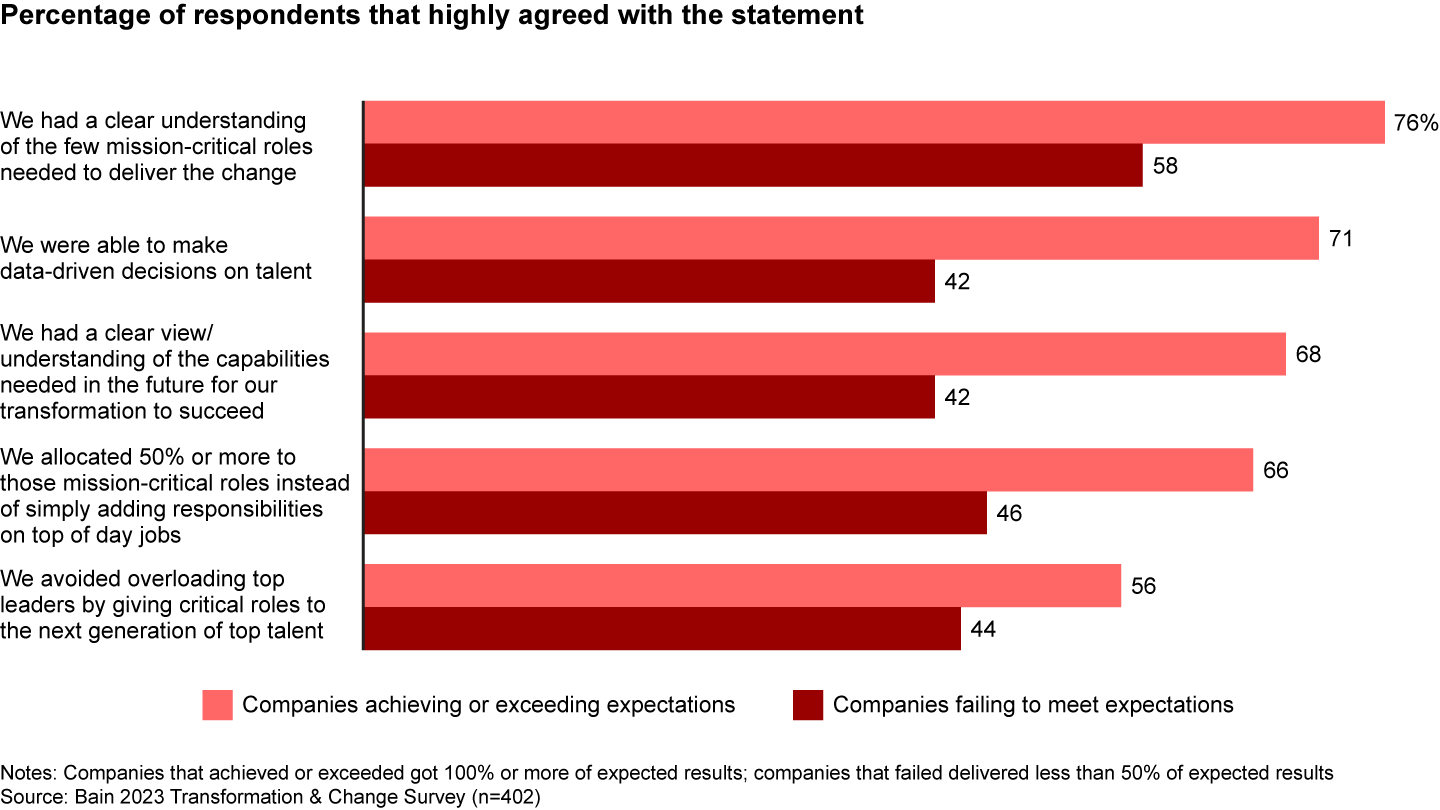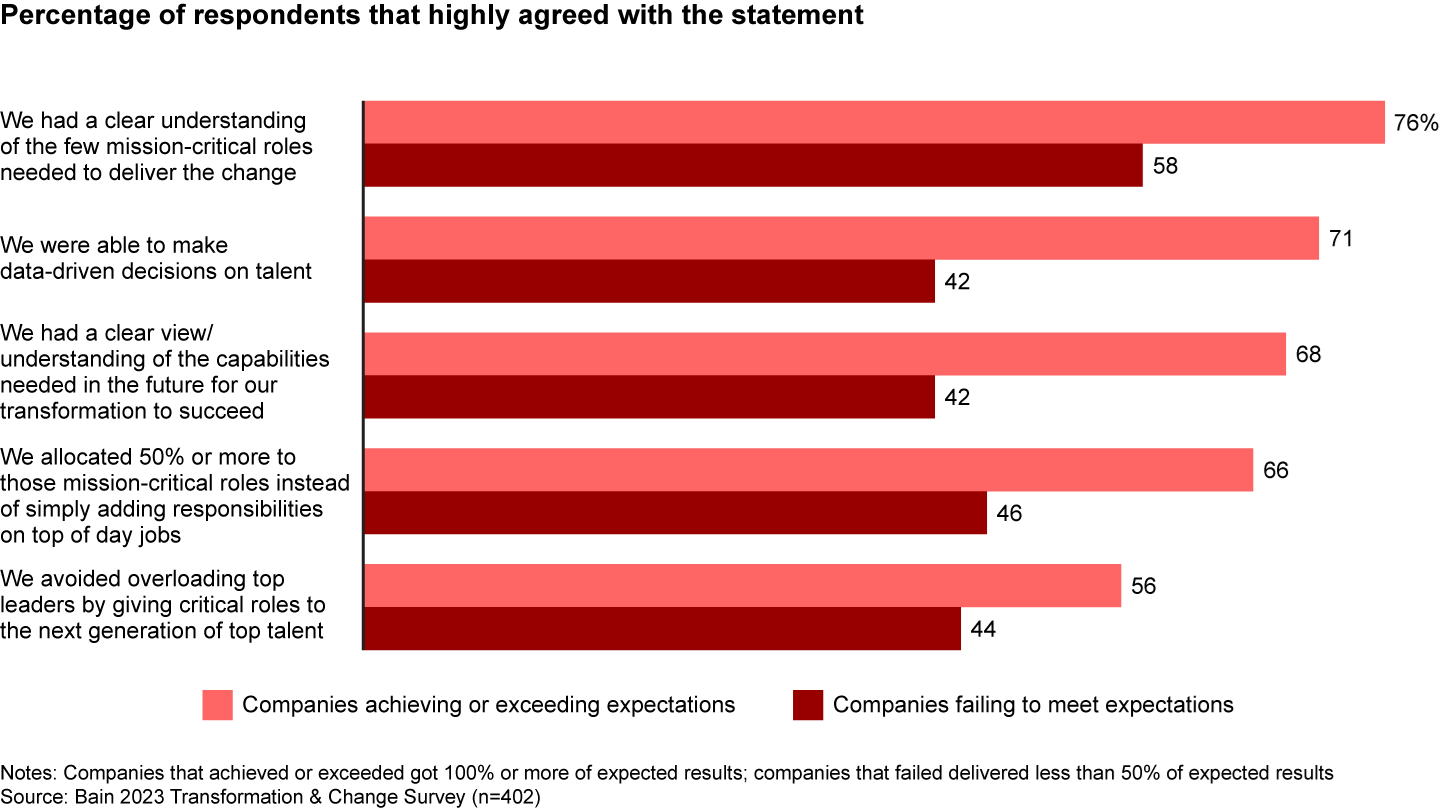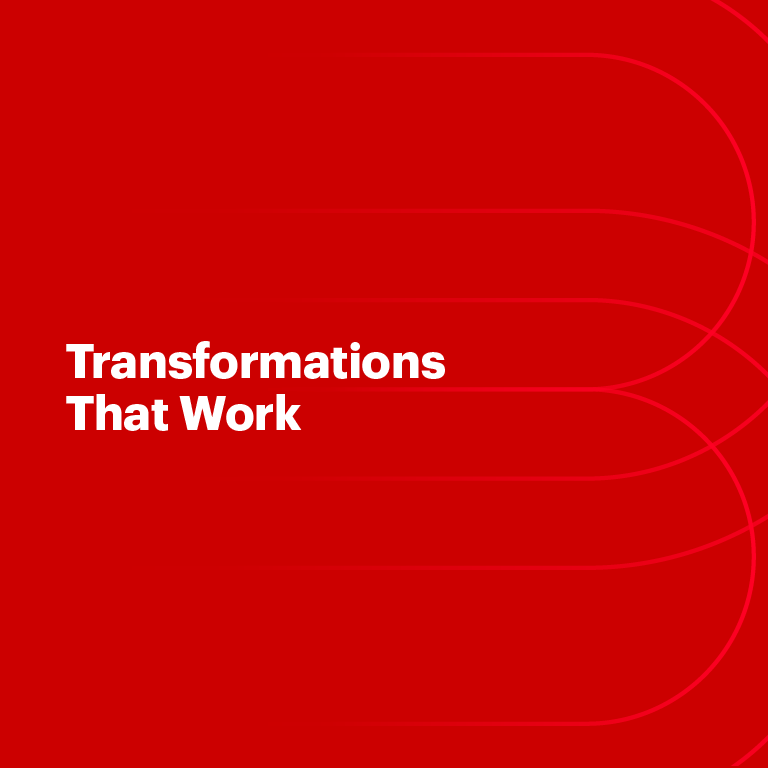Brief

A primera vista
- El primer error en materia de talento que cometen las empresas es no centrarse en sus funciones estratégicas críticas y no conseguir que las personas adecuadas las desempeñen.
- A la hora de cubrir esos puestos, demasiados ejecutivos se centran demasiado en las conocidas "estrellas", quemándolas y pasando por alto a otros talentos dignos.
- La verdadera transformación es un esfuerzo a largo plazo, y demasiadas empresas no invierten en el talento que necesitarán para mantenerla.
Mejorar la transformación es fundamental para las empresas de todos los sectores, y mejorar el enfoque del talento abordando tres fallos comunes es un punto de partida importante.
“Lo único que lamento de nuestra transformación es el talento que asignamos al trabajo", dice un alto ejecutivo de un contratista de defensa sobre su lanzamiento de un producto innovador. "Podríamos haber ido más rápido y ser más fuertes si nos hubiéramos centrado más en nuestro talento."
Establecer una agenda de transformación no es fácil, como tampoco lo es trazar un plan para empezar. Pero no son esas las cosas que más preocupan a los responsables de la transformación empresarial, sino no contar con el personal adecuado para llevarla a cabo.
Las respuestas a la Encuesta sobre Transformación y Cambio 2023 de Bain & Company, realizada a más de 400 ejecutivos y altos directivos, confirman que el factor más importante para predecir el éxito de una transformación es la forma en que la empresa retiene, desarrolla y adquiere el talento y las capacidades adecuadas para llevarla a cabo. Sólo el 12% de las transformaciones empresariales logran su ambición original, y las que lo consiguen se diferencian por la forma en que gestionan el talento (véase la Figura 1).
Top-performing business transformations differentiate themselves on five talent dimensions


Las transformaciones que se quedan cortas suelen cometer uno o varios de los tres errores típicos: no se centran en las funciones esenciales para la transformación, recurren a una reserva de talento demasiado escasa o no se preparan bien para el futuro.
Error #1: No centrarse en las funciones críticas
A menudo, las empresas no vinculan sus prioridades estratégicas a los resultados específicos necesarios en los próximos dos o tres años, lo que dificulta la identificación de las funciones esenciales para alcanzar dichos resultados y de las personas más idóneas para ocuparlas. Como resultado, con demasiada frecuencia las personas equivocadas acaban ocupando puestos críticos. Mientras que el 76% de los encuestados de empresas con un historial de transformación exitoso afirmaron que comprendían qué funciones críticas eran esenciales, solo el 58% de los encuestados de empresas con resultados mediocres consideraban que tenían la misma comprensión.
Según nuestra experiencia, menos del 5% de las funciones generan el 90% del valor y los resultados de cualquier transformación, por lo que es fundamental contar con las personas mejor cualificadas para desempeñar esas funciones. Con frecuencia, los directores generales tienen una idea general de cuáles son las funciones más importantes, pero no han articulado lo que se necesitará de cada función para que la empresa pueda cumplir su aspiración de transformación, ni han cuantificado el coste potencial de no ocupar correctamente esas funciones.
Hay otra forma de hacerlo. Pensemos en lo que ocurrió cuando un nuevo Director General empezó a dirigir las operaciones en Asia de una empresa de servicios financieros. Se emprendió una reevaluación de la estrategia de su cartera, incluidos los mercados y los clientes atendidos, así como las líneas de negocio y los productos. Paralelamente, el equipo directivo identificó 50 funciones de misión crítica en áreas clave como clientes, distribución y datos. Antes de considerar a los candidatos, crearon un "perfil de éxito" para cada puesto, relacionándolo con la estrategia de transformación y describiendo claramente lo que cada puesto debía ofrecer y las competencias que los candidatos necesitarían para tener éxito. El ejercicio ayudó a la dirección a identificar más eficazmente a las personas adecuadas para los puestos, personas que marcaron la diferencia ayudando a la empresa a cumplir su ambición de transformación.
Error #2: Confiar en una reserva de talento demasiado superficial
No mirar más allá de los conocidos "jugadores estrella" contribuye al agotamiento de ese grupo sobredimensionado, ya que a menudo se les asigna la transformación además de su otro trabajo, lo que les aboca al fracaso al tiempo que mina el impulso de la transformación.
Por el contrario, dos tercios de los encuestados de empresas fuertemente transformadoras afirmaron que sus empresas se aseguraban de que las personas asignadas a las transformaciones tuvieran al menos la mitad de su tiempo asignado a la nueva función. El 56% de las empresas fuertemente transformadoras evitaban sobrecargar a sus máximos responsables, frente al 44% de las poco transformadoras.
Es comprensible que los directores generales recurran a sus profesionales de mayor confianza a la hora de emprender una transformación. Sin embargo, dado que es casi seguro que este grupo ya está al completo, un mejor enfoque se centra en conseguir a la persona adecuada para el puesto específico. Utilizar esa lente libera a quienes ocupan el puesto para ser más creativos y abiertos de mente.

Business Transformations That Work
Business transformations are about continuously reshaping an organization. When they work, they enhance performance, increase efficiency, and create a competitive advantage.
Cuando una empresa farmacéutica comenzó a dotarse de personal para su transformación, el Director General animó a los ejecutivos a incluir en la lista a todos los buenos candidatos. Nadie se quedó fuera de la lista porque fuera demasiado valioso en su trabajo actual para que su supervisor lo perdiera. Se dejó claro a los candidatos que formar parte de la transformación sería un gran paso en su desarrollo personal y que habían sido elegidos por el Director General y sus subordinados directos. El Director General revisó anualmente los planes de desarrollo de los miembros del equipo y llegó a conocerlos personalmente. Tanto él como el resto de la cúpula directiva siguieron siendo defensores tanto de la transformación como de las personas dedicadas a ella, incluso después de que concluyeran sus misiones y pasaran a desempeñar otras funciones.
Algunas funciones creadas para la transformación requerirán una inversión inicial significativa. Más del 90% de los programas de transformación incluidos en nuestra encuesta estaban dirigidos por un director de transformación (CTO) o alguien con responsabilidades similares, y nombrar a un CTO dedicado puede tener un impacto enorme en el éxito de la transformación. Los CTO alinean los esfuerzos con la estrategia, mejoran la integración con las operaciones en curso y ayudan a cumplir las expectativas financieras. La información de la base de datos ARC de Bain de más de 24.000 iniciativas de transformación muestran que los esfuerzos de cambio a gran escala alcanzan un 24% más de su valor previsto cuando los supervisa un director de tecnología dedicado.
Error #3: Malapreparaciónpara el futuro
Dedicar demasiado poco tiempo a crear capacidades estratégicas a largo plazo compromete la capacidad de una empresa para mantener su transformación.
La verdadera transformación lleva tiempo, pero muchas empresas carecen del talento necesario para sostenerla. En la Encuesta de Talento 2022 de Bain, más de la mitad de los empleados de alto rendimiento de las empresas consideraban que carecían de las capacidades necesarias para tener éxito en puestos críticos en un plazo de 5 a 10 años. Abordar este problema requiere ir más allá de las capacidades de rendimiento que las personas necesitan para cumplir con sus descripciones de trabajo actuales, centrándose en las capacidades de inspiración, como la forma en que se motivan a sí mismos y a los demás para ir más allá. Los programas genéricos de desarrollo del liderazgo no suelen centrarse en estas habilidades inspiradoras, por lo que será necesario actualizarlos.
Una vez identificadas las carencias críticas, se pueden adoptar diversos enfoques para ayudar a desarrollar estas capacidades y comportamientos, como la formación en el aula, el aprendizaje en el puesto de trabajo, el coaching, la rotación de funciones y los estímulos conductuales, como los comentarios automáticos recogidos de los subordinados directos.
Toda transformación es un plan para abordar el cambio, y a medida que el cambio se convierte en un estado continuo en todas las industrias, el talento también debe evolucionar constantemente. Consideremos la experiencia de una empresa de petróleo y gas que se embarcó en una gran transformación para hacer frente a la interrupción de la cadena de suministro en el mercado global. Parte de la transformación requirió la transición de la organización centralizada a una cartera de unidades de negocio orientadas al mercado.
Los altos ejecutivos reconocieron que el nuevo modelo requeriría un conjunto muy diferente de equipos y capacidades. Empezaron por definir un nuevo modelo para el liderazgo de alto nivel, seguido de una evaluación del equipo ejecutivo de la empresa y, a continuación, de sus 300 directivos más importantes sobre las capacidades que la empresa necesitaría en el futuro. El CEO y el equipo de liderazgo recurrieron a un tercero para realizar entrevistas conductuales con el fin de evaluar a los líderes y, a continuación, compararon esos resultados con lo que se les exigiría en el nuevo modelo de liderazgo e identificaron las carencias. Utilizaron evaluaciones psicométricas en línea para entender lo difícil que sería cerrar cada brecha y luego empezaron a hacerlo, utilizando el coaching y otras intervenciones para empezar a desarrollar las capacidades clave en el grupo de liderazgo existente.
El enfoque identificó muchas "joyas ocultas", es decir, líderes eficaces con un estilo más tranquilo que poseían las capacidades necesarias y que, cuando se les asignaron funciones críticas de transformación, tuvieron inmediatamente un impacto positivo. El programa ha tenido tanto éxito que ahora se ha integrado completamente en los enfoques y sistemas de RRHH de toda la organización.
Avanzar
La transformación, en esencia, consiste en implicar a las personas y crear líderes. Empiece con fuerza dedicando al esfuerzo a los líderes más respetados y a los expertos en la materia más capaces y, a continuación, cree un equipo de alto nivel que esté cohesionado, comprometido y alineado. Termine con fuerza comprendiendo todas las implicaciones de talento de su transformación, incluidos los cambios más amplios de la plantilla y las competencias necesarias para llevar a cabo su estrategia futura.
El sesenta y seis por ciento de los encuestados en nuestro estudio reciente afirman haber emprendido tres o más iniciativas de cambio importantes en los últimos cinco años. Mejorar en la transformación es fundamental para las empresas de todos los sectores. Los líderes inteligentes prestarán atención a esa sensación de nerviosismo y situarán el talento en el centro de su estrategia de transformación.